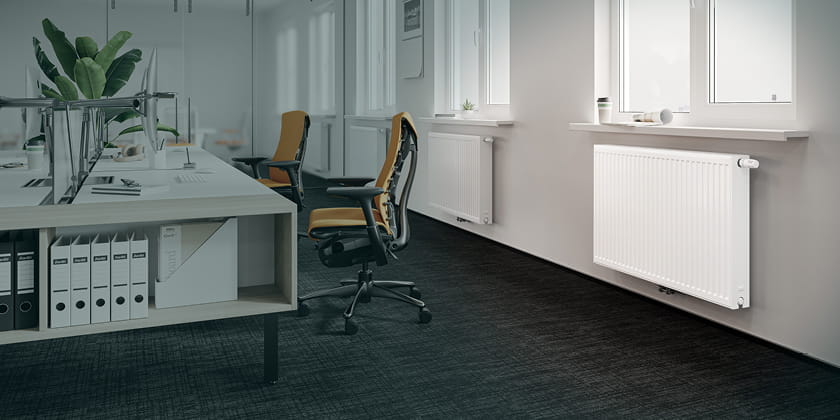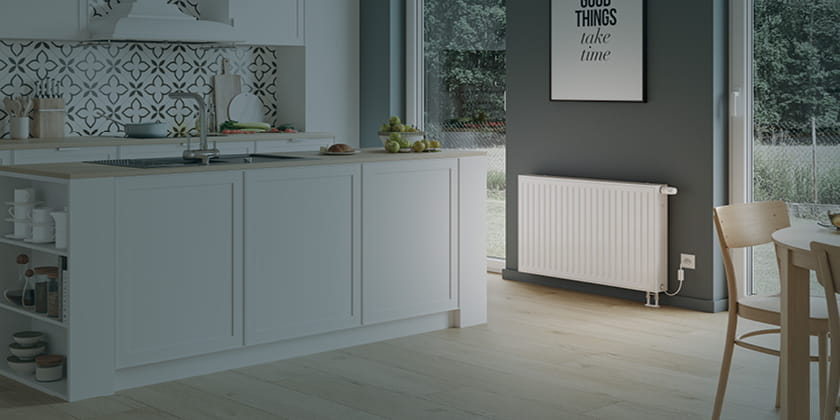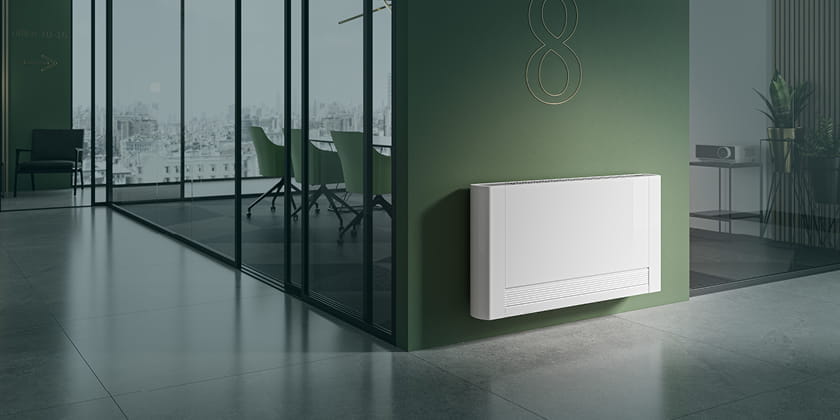- Work smarter
- Improve efficiency
- Hydronic heating
- Radiators
A comprehensive comparison: panel radiators, fan-assisted radiators, and fan coil units explained
1. Panel radiators

How they operate
Panel radiators have improved considerably in recent decades. Technological advances and innovative product design have ensured that modern panel radiators operate more efficiently. The way they heat rooms, however, remains the same. With a mixture of about 65% convection heat and 35% radiant heat (depending on the surface area ratio of water carrying radiant panel to convector fin), they distribute warmth into the room to create the desired room temperature.
Panel radiators are typically made from steel panels with a flat, fine-profiled or profiled front and filled with hot water supplied from the central heating system. They’re wall-mounted, usually below or in the vicinity of the windows, and are suitable for system temperatures from 90°C to 45°C. This makes them compatible with regular boilers as well as condensing boilers and heat pumps.
A panel radiator is generally operated with a radiator valve and thermostatic head. If you want to upgrade the radiator and increase its efficiency, thermostatic radiator valves (TRVs) or even smart controls such the Unisenza Plus electronic thermostatic head (ETH) are recommended.
Discover how heating controls help to lower the cost of comfort
Product benefits
- Classic design: most panel radiators have a classic design that’s easy to integrate in a variety of interior styles. Moreover, they are generally available with a completely flat front panel, a flat front panel embossed with fine lines or a profiled front so that there is an option for every taste. For those looking to create added value, it’s possible to order our panel radiators in over 70 different colours or to choose from a range of horizontal and vertical designer radiators.
- Silent operation: because panel radiators rely on natural convection, there is no noise, provided the installer has balanced the system correctly.
- Cost-effective: they are generally less expensive to purchase and install compared to more complex systems.
- Variety of sizes: panel radiators are available in a great variety of sizes, making them particularly suitable for replacing old radiators, but also for new builds.
Points to consider
- Gradual heat distribution: because they rely on natural radiation and convection, panel radiators may take longer to warm a room compared to fan-assisted options.
- Space considerations: panel radiators are wall-mounted, which can create design or functional limitations in some rooms. In low temperature heating systems, moreover, you need larger panel radiators to ensure the heat demand can be met. Vertical radiators are a great solution in case of rooms with limited available wall space.
Discover why vertical radiators stand out
Best applications
Modern panel radiators are real all-rounders. They can be used in private homes and residential buildings, where a cost-effective solution is often sought. However, because there is such a great variety of panel radiators available, office buildings, schools and hospitals can also easily be equipped with panel radiators that suit their needs. Our hygiene radiators, especially designed for use in healthcare facilities, are a good example of this.
2. Fan-assisted radiators

How they operate
Fan-assisted radiators operate similarly to traditional panel radiators, but they are additionally equipped with integrated fans. The fans support the convective heat dissipation and help to circulate the warm air more quickly, allowing the room to heat up faster. The fans on our Ulow-E and Ulow E2 fan-assisted radiators, for example, switch on at a return temperature of 28°C. This increases convection and creates a heat output that is up to 60% higher than a standard radiator. Thanks to this feature, fan-assisted radiators are very suitable for low temperature heating.
Ulow-E is a more basic fan-assisted radiator that serves as an alternative for a standard panel radiator in projects where only heating is required. It has a default fan setting and is controlled manually with a thermostatic head and an on/off cable switch that allows for the power to be easily disconnected, for example at night in the bedroom or in summer time.
Ulow E2 is a more advanced fan-assisted radiator with dynamic fan function. Not only is it equipped with a boost modus that helps to reach the desired temperature in the shortest possible time, it also has a dry cooling function that creates a pleasant summer breeze in combination with a reversible heat pump. Furthermore, Ulow E2 has an integrated touchpad control panel and electric actuator that together allow users to set their desired temperature, activate the boost mode and switch between heating and cooling.
Product benefits
- Faster heat distribution: the fan allows for quicker and more efficient heating, ideal for larger rooms or low temperature heating systems.
- Improved airflow: fan-assisted radiators move air more effectively, eliminating cold spots in the room.
- Compact size: because the fans boost the heat output, creating up to 65% more heat, fan-assisted radiators are sized to be smaller than traditional panel radiators. This makes them a good option for rooms with limited space or renovation projects where the system temperatures drop and old radiators need to be replaced.
Points to consider
- Sound: the addition of the fans means that this type of radiators can generate some level of noise, which might be a concern in quiet environments. Through smart product design we try to limit this however. Ulow-E for example only produces 25 dB, which is the equivalent to leaves rustling. When Ulow E2 is in boost mode it reaches up to 34 dB, comparable to the sound of someone whispering.
- Power connection required: the fans require electricity to run, which means a power socket needs to be available nearby. This may create some practical concerns, especially in renovation projects, but we see that in reality most general renovation projects these days require the installation of more power sockets anyway.
Best applications
Because they deliver heat more effectively compared to standard panel radiators, fan-assisted radiators are ideal for medium to large rooms where quicker and more efficient heat distribution is important. They are commonly used in modern homes and offices where low temperature heating is preferred.
Moreover, our Ulow-E and Ulow E2 have middle, left and right connection options. This makes them a very interesting choice for renovation projects, as you wouldn’t have to change the pipe system and can thus easily replace older panel radiators without much construction work. In one fell swoop, you can reduce the system temperatures and create a future-proof HVAC system with the latest generation of radiators.
3. Fan coil units

How they operate
Contrary to panel radiators, fan coil units can use both hot and cold water. They are equipped with a heat exchanger (coil) through which hot or chilled water flows. An integrated electric fan blows air over the coil to distribute the conditioned air throughout the room. This set-up helps to create a higher heat output at lower system temperatures and allows users to enjoy indoor climate comfort year-round with heating and cooling from the same device.
A fan coil unit such as our iVector S2 works well with condensing boilers, but is also perfectly suited to be combined with a heat pump in a low temperature heating system. Moreover, the combination of low water content and an axial fan allows the fan coil unit to respond more quickly to fluctuations in room temperature.
Our fan coil unit is equipped with an integrated control unit that allows for easy temperature control and mode adjustment. However, because the fan coil unit can be installed not only on or in the wall, but also on or in the ceiling, there is also a remote control that offers the same functionalities.
Product benefits
- Dual functionality: fan coil units can be used for heating as well as active cooling, which makes them more versatile than standard panel radiators.
- Precise temperature control: the axial fan and integrated thermostat allow for more precise control of the room temperature.
- Energy-efficient: fan coil units provide high outputs at low system temperatures. Especially in large buildings or zoned areas this offers great energy-efficiency.
- Space-saving: thanks to their high heat output, fan coil units are quite compact in size.
- Installation flexibility: fan coil units can be mounted on the wall, ceiling or floor or even integrated in the wall or ceiling. This installation flexibility creates great interior design freedom in different environments.
Points to consider
- Complex installation: fan coil units often require more extensive installation and need a power supply to run the fan. A condensate drain is also required for the active cooling function. To facilitate the installation of the iVector S2 as much as possible, we provide a clear installation guide and offer matching accessories (listed in the accessories tab on the product page).
- Air movement & dust: the fan coil uses a higher degree of convection compared to a panel radiator. This means there is more movement of air and other particles such as dust and other air pollutants.
- Maintenance: regular cleaning of the fan and heat exchanger is recommended to maintain efficiency and performance. Otherwise dust and debris can accumulate in the unit, leading to reduced airflow and potential issues with air quality.
- Sound: like fan-assisted radiators, fan coil units produce sounds from the fan, which could be an issue in certain environments. In boost mode the iVector S2 produces up to 57 dB, which is comparable to moderate rainfall.
- Higher cost: fan coil units tend to be more expensive than panel and fan-assisted radiators, both in terms of purchase and installation. Similar to fan-assisted radiators they also consume extra energy to run the fan. In boost mode the iVector S2, for example, consumes 33 W. However, because a fan convector generates such a high output at low system temperatures, it creates a more efficient system if it’s combined with an air-to-water heat pump. This combination delivers a lower COP ratio, which ultimately reduces the operating cost. We therefore recommend to consider the complete picture, meaning the cost of the HVAC system as a whole instead of the cost of the individual emitters.
Best applications
While fan coil units like the iVector S2 are a popular choice for use in commercial buildings such as offices and hotels, they are also ideal for schools, retail and many other commercial premises, where both heating and cooling are needed. More and more frequently fan coil units are also being installed in private homes. The iVector S2 can be used in new build projects, but also specified for renovation work.
Simulation
To further substantiate our comparison, we ran a simulation with two of our panel radiators (Compact type 22 and type 33), our Ulow-E and Ulow E2 fan-assisted radiators and our iVector S2 fan coil unit. We dimensioned each unit for a heat demand of 1500 W in a 30 m2 room and system temperatures of 45/35/20 °C.
| Compact Type 33 | Compact Type 22 | Ulow E2 | Ulow-E | iVector S2 (VS11) | |
| Height (mm) |
600 |
600 | 900 | 600 | 579 |
| Width (mm) | 2200 | 3000 | 1800 | 2000 | 1135 |
| Depth (mm) | 166 | 105 | 107 | 107 | 129 |
| Power (W) | 1553 | 1465 | 1458 | 1532 | 1880 |
| Speed | - | - | Medium | Medium | Medium |
| m3 | 0,219 | 0,189 | 0,173 | 0,128 | 0,085 |
| m2 (wall space) | 1,320 | 1,800 | 1,620 | 1,200 | 0,657 |
| Sound (dB) | - | - | 25 | 25 | 34 |
| Power consumption (W) | - | - | 12 | 11 | 11 |
| Water flow (l/h) | 133 | 126 | 125 | 132 | 163,5 |
The results of our simulation clearly demonstrate some of the points we mentioned above. For example, the devices equipped with a fan (Ulow-E, Ulow-E2 and iVector S2) take up less wall space than a classic type 22 radiator to deliver a comparable output. This can be very convenient in rooms with limited wall space. On the other hand, the panel radiators don’t produce sound and there is no additional power consumption to run any fans.
In case of the iVector S2 the output is significantly higher, which means there is the possibility to reduce the flow temperature even further to 40/32/20 °C. In that case the power output becomes 1490 W, which corresponds to the demand in our simulation. This clearly shows the iVector’s optimal compatibility with low temperature heating systems and its ability to generate the highest output while taking up the least amount of wall space.
Another striking element in the simulation is the water flow. This is clearly higher for the fan coil unit compared to the other emitters. A feature that affects the sizing of the pipework and is important to take into account when designing the HVAC system because if the pipes are undersized, the water flow to the fan coil unit will be insufficient, causing the output to be lower than required.
Discover more features to keep in mind when installing a fan coil unit
Comparing panel radiators, fan-assisted radiators and fan coil units
To make the similarities and differences between the 3 emitter types clear at a glance, we have combined our products in a comparative table.
| Compact steel panel radiator | Ulow-E fan radiator | Ulow-E2 fan radiator | iVector S2 fan coil unit | ||
| Installation | wall | + | + | + | ++ |
| ceiling | - | - | - | ++ | |
| Operation | passive heating/cooling | +/- | +/- | +/+ | -/- |
| active heating/cooling | -/- | +/- | +/- | +/+ | |
| Fan support | - | + | + | + | |
| Fan speeds | - | + | ++ | +++ | |
| Max. operating temperature (°C) | 110 | 60 | 60 | 80 | |
| Compatible heat sources | boiler |
+ |
- | - | + |
| condensing boiler | + | + | + | + | |
| heat pump | + | + | + | + | |
| chilller | - | - | - | + | |
| Sound power (dB) | comfort | - | 20 | 24 | |
| boost | - | 25 | 36 | 47 | |
| Power supply (V/Hz) | - | 230/50 | 230/50 | 230/50 | |
| Control | integrated/external | -/- | -/- | +/+ | +/+ |
| Maintenance | + | ++ | ++ | +++ | |
| Cost of ownership | € | €€ | €€ | €€€ | |
Final thoughts
When deciding between panel radiators, fan-assisted radiators and fan coil units, it’s important to realise you cannot compare them 1-to-1. Although they are all designed to create indoor climate comfort, each type of emitter has its own unique features, pros and cons. Panel radiators are an excellent choice for simple, cost-effective heating in residential settings, as well as schools, offices, hospitals, etc. Fan-assisted radiators provide a higher output thanks to their integrated fans and offer a great solution to create a low temperature heating systems in new builds as well as renovation projects without needing much construction work. Fan coil units, with their ability to both heat and cool at low temperatures, offer flexibility and precision, ideal for commercial spaces or homes requiring year-round climate control.
With our diverse range of heating and cooling products, including the different emitters types, suitable pipes, water and air temperature controls and valves, we aim to provide a variety of solutions that covers a variety of applications. The latter is important to mention because in addition to product functionality, it’s also vital to consider the building where the emitters will be placed and to take into account the size of the rooms, the activities performed there, the system temperatures, other emitters that might be integrated, the needs and habits of the end users, etc.
Our goal is to help our customers make an informed decision that ensures comfort and efficiency and serve as a one-stop-shop for all your heating and cooling needs. If you have any questions about the emitters discussed above or any of our other products, please feel free to get in touch. Our experts will be more than happy to help with tailored advice.

